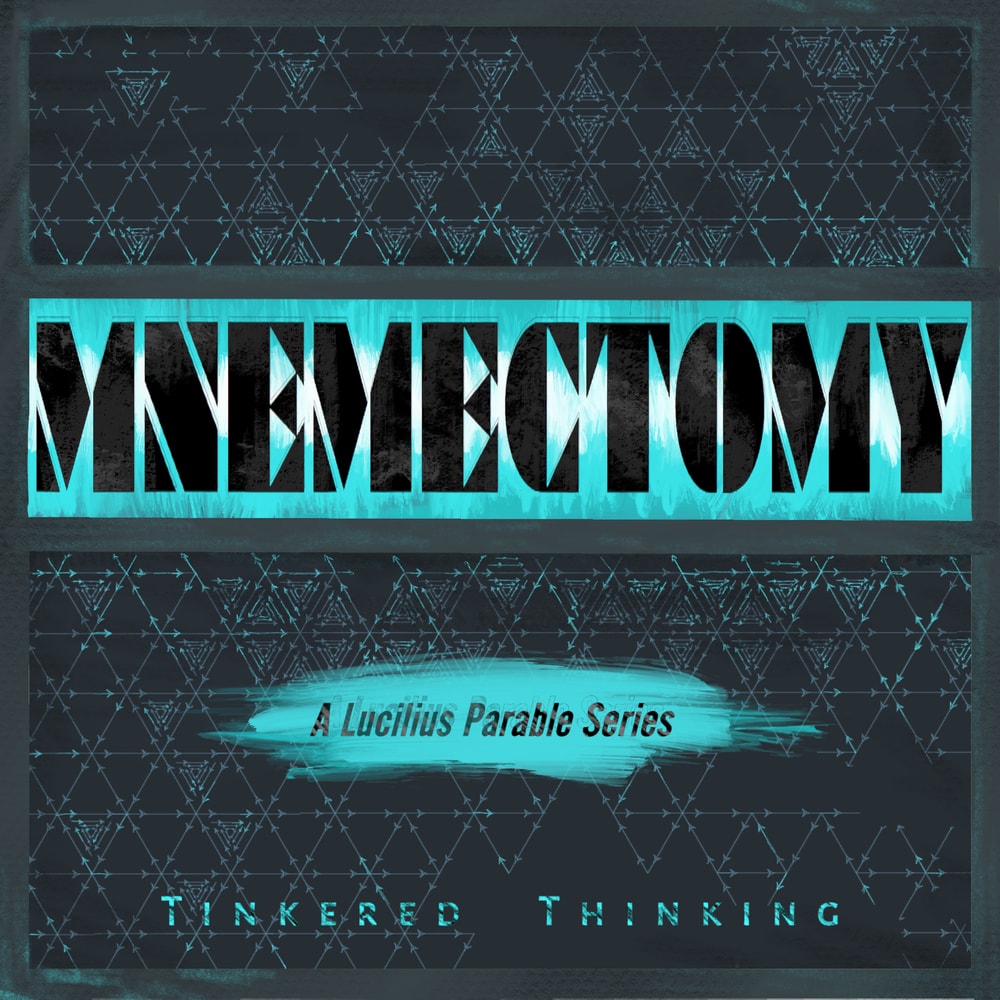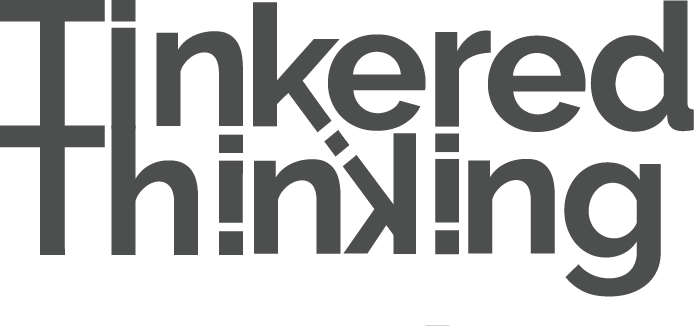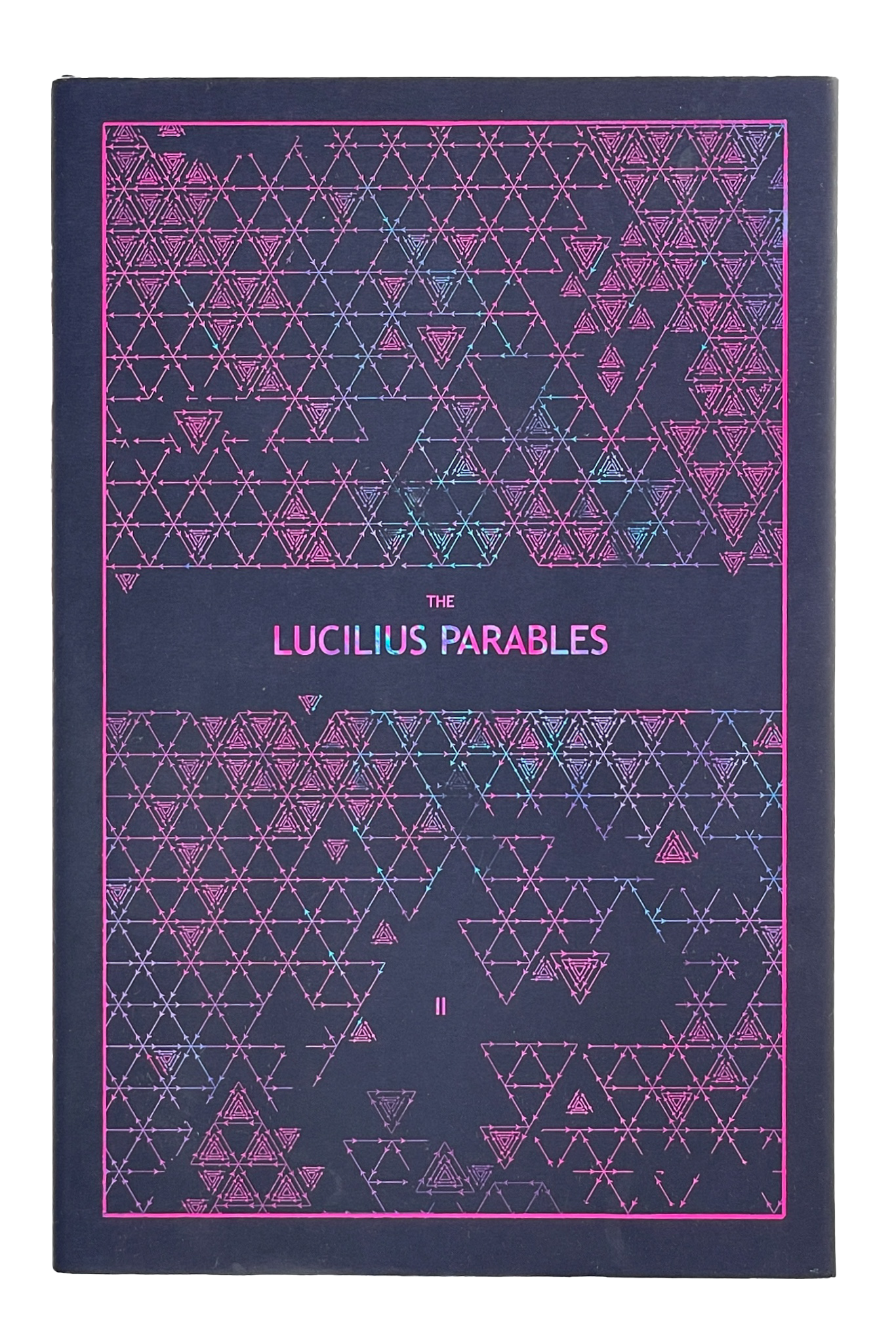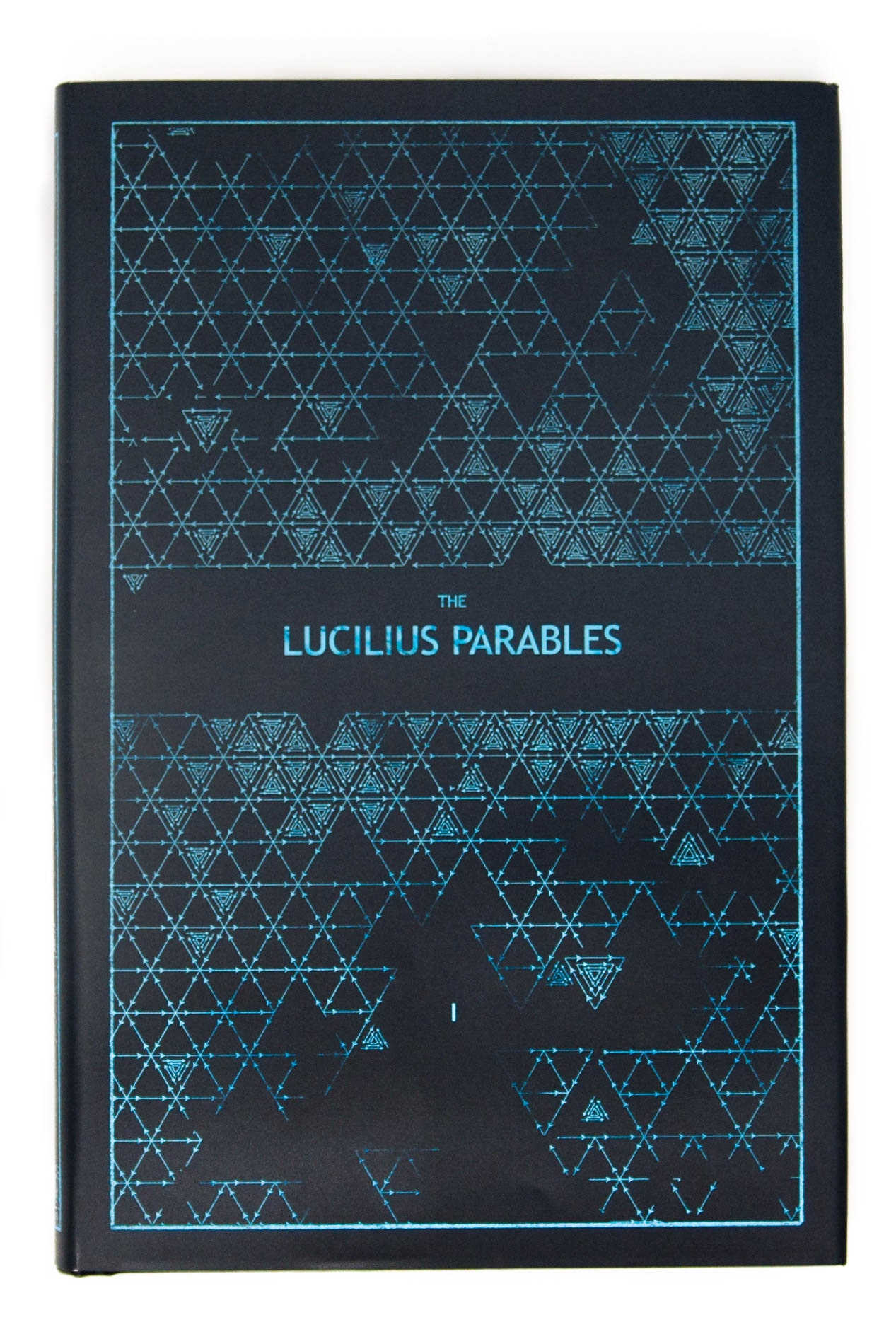Daily, snackable writings to spur changes in thinking.
Building a blueprint for a better brain by tinkering with the code.
subscribe
rss Feeds
SPIN CHESS
A Chess app from Tinkered Thinking featuring a variant of chess that bridges all skill levels!
REPAUSE
A meditation app is forthcoming. Stay Tuned.
A LUCILIUS PARABLE: CLEAVING THE DELUSION
September 30th, 2018
Lucilius celebrated his 4,000th birthday deep in the Yahwelian System where he was captain of a starship set with the task of exploring unknown reaches of space. He was looking at a drawing he had mounted on his cabin wall depicting Spock playing a game of chess with R2-D2, when he was called to the bridge by the first mate.
He got up and walked the short corridors to the command room and was briefed on the situation.
They had come across a binary planet system. Each planet was effectively in a geostationary orbit around the other, spinning together like dancers in a bigger orbit around their local sun.
What was curious about this pair of foggy planets was that on the sides facing one another, each had an elaborate, luminous design that covered nearly one half of the entire planet and was bright enough to show through the fog. It was an incredibly beautiful spectacle to see from the vantage point of Lucilius’ starship, and he could only imagine how magnificent it would look like from the surface of each planet.
Lucilius instructed his first mate and the bosun to take teams to each planet and find out what was causing these magnificent designs. Both teams teleported to the respective planets and went about their missions under the guise of invisibility cloaks.
Lucilius spent the time simply watching the magnificent designs, perfectly arrayed, almost dancing in the darkness.
It wasn’t long before both teams returned and recounted their discoveries.
According to the first mate, the planet he had visited was inhabited by a humanoid race of people and the entire civilization was geared towards creating and maintaining the elaborate design on their planet, which was achieved by burning enormous amounts of plants and tree-like creatures. The civilization was incredibly organized and all resources were slowly being hauled from one side of the planet to the other for the design.
The other team also reported on a similar humanoid species on the other planet.
At that moment the Astro-archeo officer chimed in with his analysis about the makeup and geologic origin of the planets. The two used to the be the same planet and had virtually the same exact make up, and even many of the same species survived the split from long ago, including a very recent common ancestor for this humanoid species, which explained their presence on both planets without the aid of advanced technology.
The exact same process of burning resources for the design was occurring on the twin planet.
Lucilius was confused.
“But why are they both doing the exact same thing? According to analysis, they are going to totally run out of resources very shortly. Their civilizations will collapse”
The first mate responded. “The designs have slowly been changing over the years to match the other planet. The people on both planets both believe that the design they see in the sky is their god, and they are trying to communicate with it in order to get answers to their problems.”
Lucilius thought for a moment. He walked over to the communications officer.
“Do we have a class J probe aboard?”
“Yes sir?”
“Class J has spectral disruption, correct?”
“Correct.”
“How many we got?”
“We have a full swarm.”
Lucilius thought for another moment. “What happens if you point two spectral disruptors at each other? Can you contain the field that way?”
The officer thought for a moment. “Theoretically that sounds plausible, but I’ve never heard of it being done.”
“Theoretically we could also strategically disrupt to reconfigure available light into any shape we want, given a screen created by contained disruption.”
The officer looked a bit nervous. “It might be possible.”
“Computer,” Lucilius said loudly, “Analyze the planet’s patterns, and evidence of past burns for coherence. Try to figure out a language we can use. And generate me a film of what it would look like on each planet if fires were extinguished immediately.”
Then he looked back at the officer. “Launch the swarm. Arrange them in a circle half way between the planets, at a diameter equal to the planets.”
Within hours the probe swarm was in position, and their spectral disruptors were precisely calibrated, and when turned on, they generated an enormous screen in space, upon which were images of each planet.
“From the surface of each planet it looks the same,” Lucilius said. “But now we are going to change the message.” He looked at the communications officer. “Start the film showing fires being extinguished.”
“Sir, that’s against interference protocol.”
Lucilius smirked. “If they keep up this nonsense there’ll be nothing for us to appreciate and record. Our species had it’s own delusions and we almost didn’t make it.”
SEEING THE BOOTSTRAP
September 29th, 2018
It’s possible that come Monday morning, you could walk out on your job in the middle of the day, walk to the nearest convenience store, pick a random assortment of numbers for a lotto ticket and win all the money you’d ever need for the rest of your life.
This would probably be the fastest way to bootstrap your life and level-up. Chances are slim but it’s possible.
What requires more work and is frankly a lot more interesting, is consciously levelling-up through other means. Through some other bootstrap.
Everyone has interests and hobbies that they’d much rather be doing while slaving away at some bullshit job. But few seem to explore curiosity in the direction of how one or two of those hobbies could be expanded in ways that could make money.
It’s possible that the inuring influence of a bullshit job creates a negative association with money-making. I.E. anything that makes money must intrinsically be unpleasant and soul-draining. This might be part of the reason why beginner freelancers are so tentative to charge for their work, or why artists eschew the business aspect of making a living as an artist.
Since the procurement and use of money is 100% behavioral, as in both dictate limits and patterns for behavior and activities that a person engages in, it would be astonishing to find no link between such behaviors and positive or negative associations people have with money. This is the key to seeing an all-too-human flaw: when we think we see a connection when in fact such a connection does not exist. For those people who have spent years and years procuring money only through means that they find unenjoyable, it may be very difficult for such people to imagine a life where making money can be fun. Such individuals might view the wealthy with contempt and view those who think money making is fun as greedy, unattainably lucky, or even insane.
In such an instance, we make the mistake of drawing too much of a conclusion from our own experience, and not enough conclusion from the experience of others.
It’s often said that what monkey see, monkey do.
But perhaps what’s an even more powerful statement about human behavior is : what monkey will do is what monkey has always done.
Our experience, like our thoughts can have an unfortunate reinforcing quality if change is not systematically injected into the equation. For those people who experience change as unexpected and imposed by the external forces of life, change can likewise garner a purely negative association.
This two-fold associative monster may be responsible for the prison-trap that many people find to be their life. No effort to level-up one’s life is made because not only is change associated with negativity, but so is the most obvious ingredient for human agency: money.
Luckily, money is not the only ingredient for human agency: hence the whole concept of bootstrapping one’s self in order to level-up.
It’s not a pile of cash that you need to go find first in order to do something fun, worthwhile and potentially lucrative. It’s the mess of one’s life, or one particular thread of that mess that we need to carefully pull on - doing so might just unravel the associative illusion that blinds us from seeing that a better life is possible.
This episode references Episode 166: The Mess, and Episode 42: Level-Up
THE MESS
September 28th, 2018
A study of ancient myth and religion invariably starts with stories about the origin of everything. This is commonly described as a ‘void’ or some kind of ‘chaos’. From this strangely chaotic blank canvas, creation starts to happen and things pop into being.
This idea of things popping into being is an interesting one: for example, we might ask, at what point does a fighter jet pop into existence? There is a definite point in the construction of a fighter jet when it goes from a non-functional state to a functioning state. Is it still a fighter jet the moment before that final piece is put in that makes it functional? Or is it just a giant, semi-organized mess of parts?
Any act of creation requires these initial states. We have to make a mess of things. We have to take Pandora’s jar and lift the lid a little to let some of that original chaos out. Like a toddler opening a toy box and pulling out all sorts of goodies to interact with. Any parent knows just how much chaos seems to be required for learning and more importantly, for having a good time.
(It’s interesting to note how adults rely on substances to systematically force chaos back into their mentalities for enjoyment. Alcohol is perhaps the most prevalent and obvious example of a ‘chaos aid’. Unfortunately such an aid rarely leads to results of lasting value, particularly when one of the chief results is a short supply of memory. But still we crave this chaos because we perhaps remember engaging in it so unselfconsciously as children and know what good learning can occur.)
The mess is diametrically opposed to the perfect ideal. When, for example, we think of some project, or some endeavor, we picture the ideal outcome, the perfect result. And this is one of the worst, most paralyzing traps of all, because it comes with the false notion that if we just think through something carefully enough, we can picture the outcome so perfectly that when we finally begin to take action it will be like tipping the first of a long line of dominoes and everything will systematically lead to the perfect outcome. This is a pure mental trap. First and foremost because the entry fee for any project is to engage with chaos, to unleash a mess, and then from that big pile of unorganized resources, pull out the necessary parts and pieces and organize them in such a fashion as to approximate the original idea. The long line of dominoes for instance does not simply materialize. We must open the box of dominoes and spill them out onto the floor and then pick them out one by one in order to build our chain reaction.
We will hear someone say, on occasion, “my life is a mess.”
And this generally means that things are chaotic and out of control.
But it also means that there’s probably a lot of untapped and unorganized resources at hand.
Saying, “my life is a mess,” is a negative spin on a ripe situation.
When in fact, with a shift in perspective, it could be the initial conditions required to create something truly awesome.
This episode references Episode 39: The Resources.
SET SAIL
September 27th, 2018
Imagine for a moment being on an unsinkable boat that has no sails and no engine. What would life be like?
Calm days on the sea could very easily be wonderful. But then when storms come, the boat would toss and roll in the huge waves and chances are the experience would be miserable.
Let’s add something to this image. Below the deck in the main cabin is an endless supply of raw materials. There’s wood, there’s fabric, there’s metal and machine tools, saws, drills, it’s a complete workshop that, given the right knowledge, anything could be built. We could do nothing, and just drift. Sure the storms would be uncomfortable as the boat would roll down the face of huge waves over and over, but storms pass.
Or we could get busy. With the right knowledge, an engine could be built and attached to the boat, and if we could find some way to power it, we could get on our way in any direction no matter what.
Or, we could build a mast and affix it to the boat. Cut and sew sails, raise them, and then slowly learn how the wind pushes the sails and how we must trim and steer the boat. Waves would no longer be random events that push the boat this way or that way. With sails and some wind and some slowly growing know-how, we could cut those waves and steer in some direction, course correcting as we go.
This unsinkable boat with infinite resources is the human mind.
We can dilly-dally doing nothing and drift through life, letting the storms of life throw our minds into chaos, waves tossing us this way and that way.
Or we can get busy. We can discover or invent any concept we need to get our mind sailing in a better direction. We can hone our ability to question ourselves, and create motivation, create wind to fill whatever sails we’ve fashioned.
We can see what works, and then make improvements. Add another mast, more sails, different shapes, and trim them with more sensitivity, with a greater intuition about the waves and the wind.
Our ability to course correct can become fine-tuned so that we can steer calmly through storms or avoid them altogether.
Perhaps we managed to build some measly little sail, but we’ve got the steering wheel hard over and stuck. Perhaps we’re just stubbornly sailing in circles because we’re unwilling to learn more about how to steer and what to look for, and maybe what better sort of set of sails we could make. Perhaps we’re too afraid to set more sail and see what will happen….
Imagine someone admirable. What would they look like in this circumstance? Would they have one dinky sail up and the wheel hard over and unattended?
Or would they look like the saltiest sailor alive, with a boat heeled over from the largest set of sails they could get the boat to handle filled with wind, cutting the water furiously, flying towards some beautiful horizon.
We might go back below decks. Back to the drawing board and wonder. What else can I do to get myself where I want to go?
MOVING THE WHIRLPOOL
September 26th, 2018
In many of these episodes, the whirlpool has been used to visualize vicious and virtuous cycles, as with regards to habits both good and bad.
Habits compound on top of themselves to create both momentum and substance. The Tinkered Thinking platform, for example, started from a mere habit of writing daily. Now, in terms of word count, it is larger than a five hundred page book. Such is the result of a virtuous cycle.
As for vicious cycles, we all have enough experience with bad habits to know what it’s like to go down the drain in some respects. And this whirlpool is a tidy and beautiful way to see a process that exists as behavior in a more abstract way.
Since good and bad habits both have the same basic structure of compounding repetition, and therefore both can be visualized as a whirlpool, meaning we do not need two different structures to understand or visualize good and bad habits, it’s worth wondering how to move or alter a habit. Often we think improvements are made by ripping down an entire structure and building a new one, and while this can be a valid way to make improvements, it need not be the only one. It begs the question, can we move existing habits around?
If we go back to the image of the whirlpool, what sort of answer begins to materialize if we pose the same question:
how do you move a whirlpool?
To begin thinking about this odd question, we are first faced with another question: what exactly is the whirlpool? We cannot exactly pick it up or push it without the risk of destroying the whirlpool. We realize quite quickly that the whirlpool is not just the exponentially V-shaped cone that cuts down into water.
The whirlpool that we see is the cumulative result of much larger forces and movements occurring around the whirlpool. The whirlpool is just the intersection of these forces.
Just as someone’s emotions are not merely the movements of muscles on their face, the facial expressions they make are merely a part of the cumulative result of much deeper processes that are occurring in the brain behind those expressions.
To move a whirlpool requires first Zooming-out and looking at a much larger context that includes the large moving forces that eventually intersect and result in a whirlpool. We may discover that there are multiple forces acting upon one another that result in this whirlpool, and just as a puppet master controls puppets from a distance, we would have to concede that moving a whirlpool would require altering these forces. We would probably have to alter these forces simultaneously in order to maintain the integrity of the whirlpool.
Naturally there might be limits to how far we can move a whirlpool based on the nature of these different forces.
We may even find that we can swap out one of these influencing forces with a totally new one and achieve a different sort of whirlpool.
Take the common bad habit of biting one’s nails for instance. It’s a simple habit, a whirlpool that actually isn’t too hard to move.
Often we look at such bad habits and think the answer is the cold-turkey approach: to just stop doing it, to just have more willpower, but this ignores the fact that our nails still continue to grow and there’s something that needs to be done about that.
Moving this whirlpool can be as simple as carrying a nail file around all the time. It’s much easier to stop biting one’s nails the instant we notice if we have the option of pulling out a nail file to finish the task. Otherwise, we risk being reacquainted with the all-to-eerie and unsettling experience of noticing we are doing something we wish we wouldn’t but simultaneously finding we cannot stop ourselves.
Note also the difficulty of totally killing off a real whirlpool. It might be small enough, say in a bathtub where we can destroy the whirlpool by passing our hand through it, but if the larger forces responsible for the whirlpool remain active, chances are that whirlpool will materialize again, and again.
It’s like hacking at the leaves of a problem instead of recognizing the root is where we should be striking.
As with the small example of biting one’s nails, carrying a nail file constantly is akin to redirecting one of the forces that creates the bad habit, therefore moving the whirlpool into a different place, a better place where we can turn a bad habit into a virtuous cycle.
This episode references Episode : The Well-Oiled Zoom.
-compressed.jpg)





